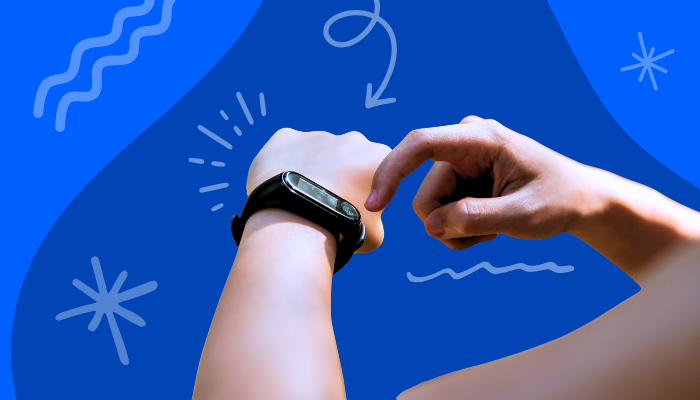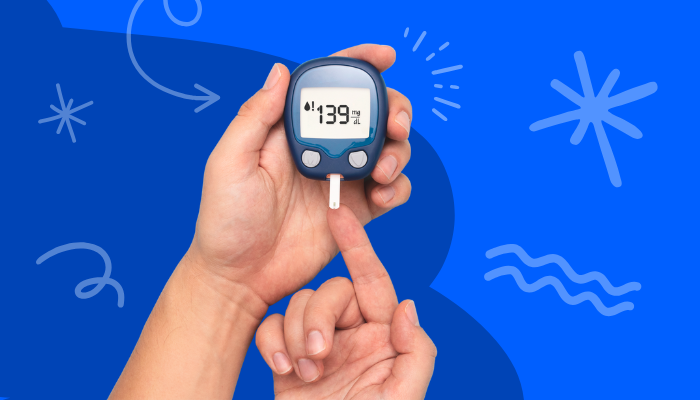Table of Contents
Some smartwatches now offer real-time blood glucose readings, but this functionality is controversial. People with diabetes rely on accurate glucose readings to manage their symptoms and correctly dose medication. But is your smartwatch’s glucose readings accurate enough to help you manage your diabetes?
Definitely not—for now. And we’re here to explain why.
The Rise of Non-Invasive Blood Sugar Monitoring
More people than ever are diagnosed with diabetes, which means more people than ever are monitoring their glucose. And over recent years, glucose monitoring has become a wellness trend.
Glucose monitoring methods involve needles to pierce the skin and collect blood samples, like using a glucose meter or a continuous glucose monitor. Although people get used to the process, drawing blood is never pleasant. So, scientists have been exploring new non-invasive methods.
Researchers have been testing transdermal sensors, or devices that take readings through the skin, to read blood sugar levels. These sensors may use various methods. Some might send light waves or microwaves through the skin, and the waves that are absorbed or reflected tell us how much glucose is in your blood. Others might use sweat samples instead of blood.
Today, you’ll find smartwatches and smart rings that claim to read glucose levels using some of these methods. But they have major limitations.
How Accurate Are Smartwatches for Blood Glucose?
While some of these new blood glucose monitoring methods seem promising, they’re not nearly as accurate as they should be, especially if our health counts on them.
In fact, the Federal Drug Administration (FDA) has warned against using smartwatches and smart rings to measure blood glucose levels because they’re “not authorized, cleared, or approved” to do so.
But there’s hope for the future. One small study showed that one device, the GWave, was highly accurate among 43 people. Science seems to be moving in the right direction, but the FDA needs to see more consistent results to meet its strict accuracy requirements.
Alternative Blood Glucose Monitoring Devices
Drawing blood is still the best and safest way to monitor blood sugar. Most people with diabetes are familiar with the traditional method of using a blood glucose meter. This involves pricking your finger with a lancet (a small needle) to draw blood, collecting the blood on a testing strip, and then analyzing the sample with the meter to get a result.
TRUE METRIX Meter Starter Package

$ 46.30
$ 57.88
TRUE METRIX Glucose Testing Starter Package Includes: TRUE METRIX Self-Monitoring Blood Glucose Meter Starter Kit 100 TRUE METRIX Blood Glucose Test Strips 100 TRUEplus Single-Use Lancets 30 Gauge TRUEdraw Lancing Device Meter Carrying Case TRUE METRIX Control Solution TRUEplus Soft… read more
But many people opt for a newer, more convenient method called continuous glucose monitoring (CGM). This uses a small device that attaches to your arm (adhesive tape helps) and analyzes blood samples using a sensor under the skin. Right now, a CGM is the least invasive option for people with type 1 and type 2 diabetes.
But a CGM is like a smartwatch or smart ring in many ways. Since it’s attached to your body and constantly taking samples, you can get real-time results without re-pricking your skin. Results are sent to a device so you can read them.
The Dexcom G7 CGM is a great example. Its sensor syncs to your smartphone and smartwatch to send results to the brand’s app. It also notifies you if your sugar levels are high or low (as determined by your doctor), so you can take action before it negatively impacts your health. And if you want to check trends throughout the day, your app will display a chart over time with your readings. You can even log other events, like exercise or insulin dosage, to see how your body responds.
Dexcom G7 CGM System

$ 161.99
$ 205.99
The Dexcom G7 Continuous Glucose Monitoring System (CGM) is a comprehensive system that has changed the way individuals living with diabetes have monitored and maintained their blood glucose levels. Dexcom G7 is for patients two years and older with any type… read more
Bottom Line
If you have diabetes, you rely on accurate blood glucose readings to protect your health. Some smartwatches claim to monitor your glucose, but they aren’t accurate, which can be dangerous. Currently, the safest method for checking blood sugar levels is by drawing blood with a glucose meter or CGM. But researchers are looking for less invasive alternatives.
FAQs
Is there a smartwatch that checks blood sugar?
Some smartwatches claim to check blood sugar, but they’re not as accurate as glucose meters or CGMs. The FDA has warned against using smartwatches for glucose monitoring, so steer clear of the claims and stick with what works, especially when your health depends on it.
What is the FDA-approved glucose watch?
There is no FDA-approved glucose watch. Do not use smartwatches to monitor glucose, as they are not accurate enough at this time.
Can an Apple Watch monitor blood sugar?
Apple has not released technology that monitors blood sugar accurately. But it can sync with CGMs that do, allowing you to check and track blood glucose results over time from your sensor’s data.







